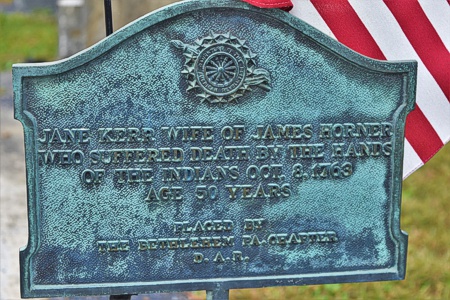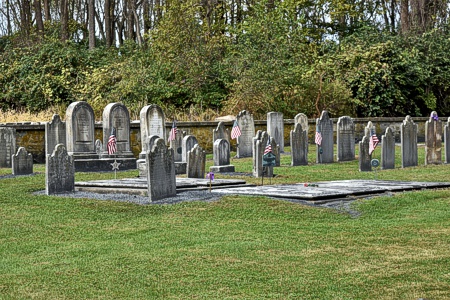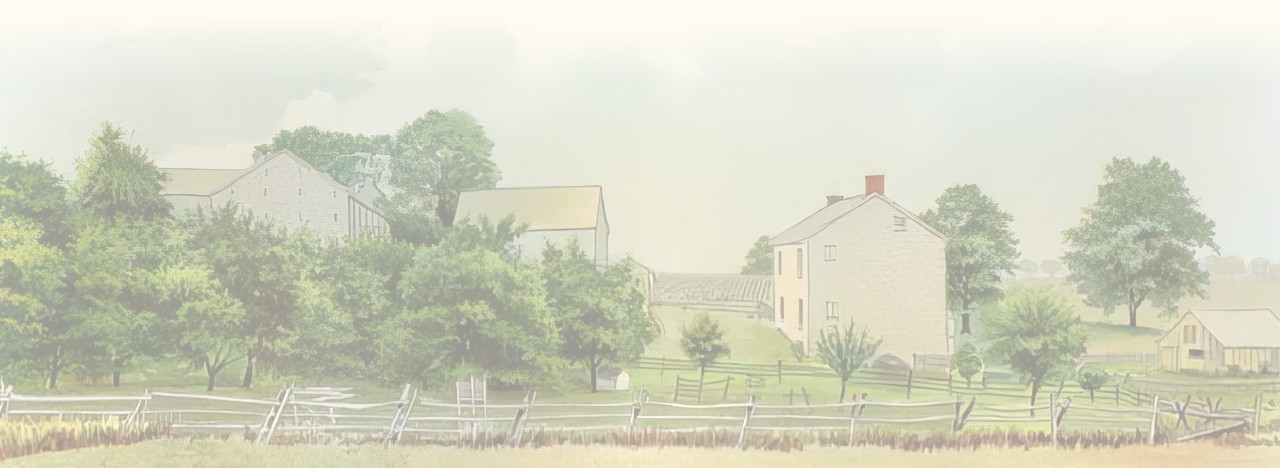Horner's Cemetery
 Horner's Cemetery is the oldest cemetery in Northampton County. The land Horner's Cemetery lies on was part of Craig's Scotch-Irish Settlement. A group of Ulster Scots immigrated to Philadelphia, and settled in Northampton County in 1728. Craig's Scotch-Irish Settlement was the first and longest permanent settlement in Northampton County. Interred at Horner's Cemetery are the founders of Bath and Northampton, along with Allen and East Allen, with parts of Lower Nazareth, Lower Moore, and upper Hanover Townships.
Horner's Cemetery is the oldest cemetery in Northampton County. The land Horner's Cemetery lies on was part of Craig's Scotch-Irish Settlement. A group of Ulster Scots immigrated to Philadelphia, and settled in Northampton County in 1728. Craig's Scotch-Irish Settlement was the first and longest permanent settlement in Northampton County. Interred at Horner's Cemetery are the founders of Bath and Northampton, along with Allen and East Allen, with parts of Lower Nazareth, Lower Moore, and upper Hanover Townships.
While the newly settled community struggled to establish itself in the New World, with peaceful Indian neighbors. Lt. Dodge angered Indians outside this area. On the way to get revenge on Lt. Dodge, they came across Jane Horner and they had to silence here alarms. She became the first woman killed by Indians in Northampton County, as well as the namesake for Horner's Cemetery.
The cemetery holds the remains of many founders and notable figures of Northampton County, including three generals, seven esquires, four doctors, three ministers, and at least 24 documented veterans of four different US wars, including the French & Indian War.
 The most prominent citizen buried there is Gen. Robert Brown, the son of Samuel Brown. Samuel was one of the first 15 families to settle in Craig's Scotch-Irish Settlement in 1728. With the approach of the American Revolution, Robert Brown and his neighbors joined the Northampton Militia.
The most prominent citizen buried there is Gen. Robert Brown, the son of Samuel Brown. Samuel was one of the first 15 families to settle in Craig's Scotch-Irish Settlement in 1728. With the approach of the American Revolution, Robert Brown and his neighbors joined the Northampton Militia.
Brown would engage the British Army on many Revolutionary War battlefields. Brown would later be promoted to lieutenant and, with his comrades, fought bravely, only to be captured in New York by the British at Fort Washington. Brown was later transferred and held on the British ship named The Judith. Eventually, he was paroled, pledging not to rejoin the militia.
The very next day he took up arms again and joined the colonial troops entering Canada, to keep the British out of Canadian ports. He was promoted to general. During his service, he met Gen. George Washington, and they became friends. Gen. Brown would be invited to Mount Vernon, where General Washington presented a gift of two chestnut splings. The one that survived was named the Washington’s Friendship Tree, now known as the Friendship Tree. The majestic tree was damaged by lightning in 1921. Today, it is a symbol on the East Allen Township flags.
When Gen. Brown returned home, he married and built a home in Allen Township. In 1842, a section of Allen Township was organized as East Allen Township. Gen. Brown continued to serve our nation when he was elected as Northampton County's first Pennsylvania senator. This highly respected citizen and soldier died Feb. 26,1823, and was buried in Homer's Cemetery.
The cemetery also holds the remains of many movers and shakers of their time. George Palmer, Deputy Surveyor General of PA. Friend with the Penn families, and settled many disputes on the border of states. We cannot forget our 2 delegates to the Continental Congress and Constitutional Convention. They helped frame the documents of this country.
John Hays was a friend of Benjamin Franklin. John owned Hay's Tavern (Weaversville Hotel). One of the founding Craigs is the confirmed ancestor of Teddy Roosevelt. Pres. Truman may have descended from our Gregg family. The burial grounds are classified as a pre-Revolutionary War Cemetery. The last interment was in 1946, so by PA. law the cemetery is closed to any more burials. Tours by appt. Call Peggy at 610-984-4532.



